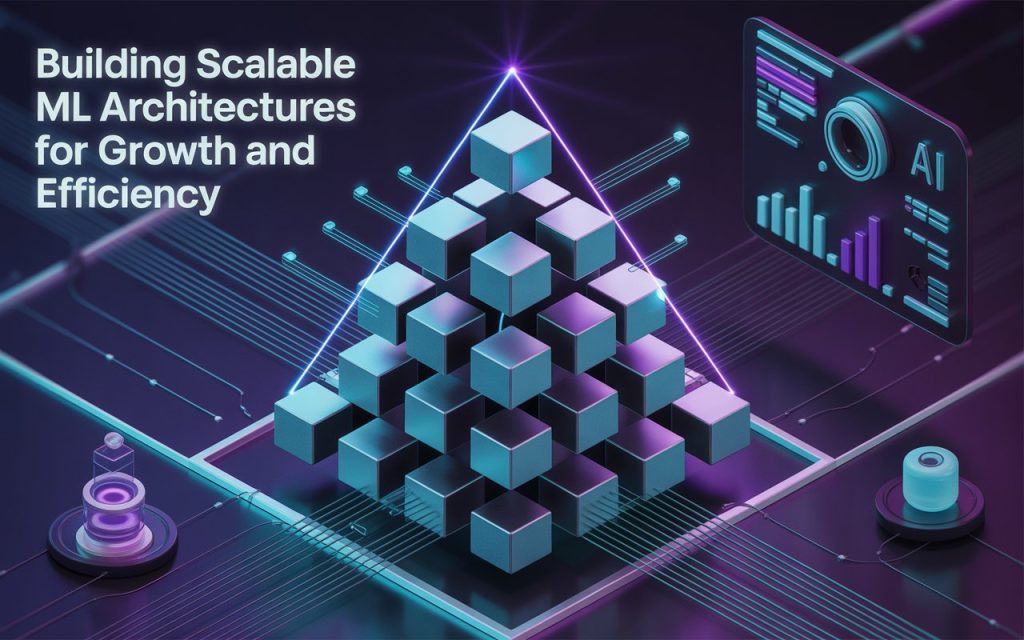A2Bookmarks India Social Bookmarking Website
Welcome to A2Bookmarks India, the premier social bookmarking platform tailored for individuals and businesses across India. Our website empowers you to effortlessly bookmark and showcase your web pages, driving enhanced online visibility and engagement. With specially curated business categories and the latest SEO-friendly tools and trends for 2025, we help elevate your digital footprint in a competitive online landscape. Join the A2Bookmarks India network today and take your website or business to new heights with ease and efficiency.


Building Scalable ML Architectures for Growth and Efficiency webcluesinfotech.com
In today’s technology-driven world, businesses are increasingly turning to machine learning (ML) to drive decision-making, improve workflows, and deliver smarter customer experiences. From predictive analytics in finance and supply chain optimization in logistics to personalized recommendations in retail, ML applications are expanding rapidly across industries. But as organizations adopt ML, the challenge often lies in deploying models at scale. An ML solution that works well in a sandbox setting may struggle when faced with real-world workloads, growing volumes of data, and the operational needs of a business. This is why building scalable ML architectures is critical for both growth and efficiency.
When businesses consider investing in ML, they often start by looking for the right ML development services partner. While proof-of-concept models are useful to test feasibility, a successful deployment requires a production-ready system that can adapt to larger data sizes, heavier user loads, and continuous integration of new inputs. Scalable ML architectures help organizations achieve this by providing flexibility, performance reliability, and long-term sustainability. Companies that aim to grow with ML must think strategically, not just about creating models, but also about the infrastructure, frameworks, and practices needed to scale them effectively.
Why Scalability Matters in ML
The primary purpose of an ML solution is to analyze data, uncover patterns, and deliver predictions or insights that guide decisions. However, these systems rarely remain static. A model that performs well on limited datasets may encounter new challenges in production environments:
-
Growing Data Volumes: Businesses collect more data every day, from customer interactions to IoT sensor readings. Models must be designed to incorporate, process, and retrain on this increasing volume of information.
-
User Demands: In consumer-facing products (e.g., e-commerce, fintech apps, healthcare platforms), large-scale user bases expect fast responses. Performance bottlenecks can lead to negative customer experiences.
-
Complex Data Sources: Real-world ML requires data integration from multiple sources—structured, unstructured, streaming, or batch. Scalability ensures smooth handling of these diverse inputs.
-
Continuous Learning: Over time, the environment changes and models must adapt. Scalable pipelines support frequent retraining and redeployment without major operational disruptions.
-
Cost Efficiency: Scaling the right way minimizes wasted resources by combining flexible architecture choices with optimized computing strategies.
In short, scalability allows businesses to turn ML from a limited-use test environment into a central driver of growth, delivering efficiency and adaptability that can handle future challenges.
Core Pillars of Scalable ML Architectures
A scalable ML system is not just about the models—it is about the end-to-end ecosystem that supports them. Several pillars define successful architecture design.
1. Data Infrastructure
Data is the foundation of ML. Building scalable ML begins with a robust data infrastructure that can handle large quantities at different velocities and varieties. This includes:
-
A centralized data warehouse or data lake to unify storage.
-
Support for batch and streaming data processing.
-
Scalable ETL pipelines for data cleaning, feature engineering, and integration.
Cloud-native services like AWS S3, Google BigQuery, Snowflake, and Azure Data Lake are popular because they scale dynamically. The ability to expand storage and processing power as needed prevents bottlenecks that otherwise derail ML projects.
2. Model Development Lifecycle
Model development should adopt modular practices so that experimentation, training, and deployment are repeatable and efficient. Important practices include:
-
Notebook-to-production pipelines for faster prototyping.
-
Containerization (e.g., Docker) to standardize execution environments.
-
Version control for datasets and models.
These practices make collaboration easier across ML teams, reduce inconsistencies across environments, and support the scaling of workloads onto larger clusters when needed.
3. Model Deployment and Serving
In scalable ML systems, deployment is designed for reliability and responsiveness:
-
Models may be served via APIs, microservices, or edge deployments depending on business needs.
-
Load balancing ensures response times don’t degrade with traffic spikes.
-
Tools like TensorFlow Serving, TorchServe, or KFServing provide scalable model serving infrastructure.
The deployment strategy should also include canary releases or A/B testing to minimize risks when new models are rolled out.
4. Monitoring and Maintenance
Machine learning systems can drift over time as data environments change. Monitoring keeps deployments aligned with business requirements:
-
Track key metrics like latency, throughput, and error rates.
-
Monitor model accuracy with real-world data to detect drift.
-
Automate retraining pipelines where consistent updates are required.
Monitoring ensures that as systems scale, performance isn’t compromised.
5. Automation and MLOps
Just as DevOps reshaped software development, MLOps brings scalability to ML:
-
Automated CI/CD pipelines for ML models allow frequent, reliable deployments.
-
Infrastructure-as-code ensures scalable environments can be reconstructed quickly.
-
Workflow orchestration tools (e.g., Kubeflow, MLflow, Airflow) automate repetitive tasks.
MLOps improves collaboration between data science, engineering, and operations teams, making scalability both manageable and cost-effective.
Strategies for Building Scalable ML Architectures
A scalable strategy is about aligning technology, people, and processes. Below are key strategies to adopt:
Use of Modular Architecture
Breaking ML systems into modular components allows each part—data ingestion, preprocessing, training, serving—to scale independently. For example, streaming data ingestion can scale horizontally with Apache Kafka, while model training can scale vertically using GPU clusters.
Distributed Computing
Distributed training frameworks (e.g., Horovod, TensorFlow distributed, PyTorch distributed) allow models to learn from massive datasets across clusters. Spark MLlib is valuable for handling distributed computation when both data volume and model complexity grow.
Adaptive Models and Incremental Learning
Instead of retraining from scratch, incremental learning techniques allow a model to update with new data in smaller iterations. This conserves resources and reduces downtime.
Cloud-Native Infrastructure
Cloud systems provide elasticity: automatically adjusting resource allocation based on demand. This flexibility allows organizations to scale compute instances, storage, or GPU resources on demand without upfront capital investment.
Edge Computing for Scale
For IoT and telecom use cases, sending all data to centralized clouds is inefficient. Scalable ML strategies involve deploying lightweight models at the edge, closer to the data source, to reduce latency and bandwidth usage.
API-first Deployment
Exposing models via APIs makes them consumable across teams, applications, or services. This eliminates bottlenecks, speeds up integration, and supports wider adoption across business units.
Balancing Growth with Efficiency
While scalability supports growth, it must also be done efficiently. Businesses must focus not only on system capacity but also on cost-effectiveness and sustainability.
Cost Optimization
Growing ML workloads can easily spiral into high cloud costs. Efficient scalability requires:
-
Spot instances and autoscaling in the cloud.
-
Model compression techniques to reduce hardware requirements.
-
Efficient pipelines to avoid redundant data transformation or training.
Hybrid Infrastructure
Some organizations combine on-premise and cloud resources for better control over costs and compliance. Scalable ML architectures can support hybrid deployment by designing infrastructure that integrates both seamlessly.
Resource Allocation
Workload orchestration tools (e.g., Kubernetes) optimize how resources are distributed across tasks. By scaling only what is needed, organizations prevent waste and preserve efficiency while still accommodating growth.
Real-World Business Applications
To illustrate the importance of scalable ML architectures, let’s look at some industry use cases:
-
Retail: Personalized product recommendations powered by ML require scalability. As user bases grow during holiday seasons, recommendation engines must handle higher request volumes without slowing down.
-
Healthcare: Scalable ML enables hospitals to process larger patient datasets continuously, supporting predictive diagnostics and resource planning.
-
Finance: Fraud detection models must handle millions of transactions per second with consistently low latency to protect businesses and customers from losses.
-
Logistics: Delivery networks depend on scalable prediction engines to reroute traffic, track shipments, and optimize fleet operations in real time.
-
Manufacturing: Predictive maintenance models scale to monitor thousands of machines, minimizing downtime with cost efficiency.
Each case shows that scalability is not an abstract concern—it directly impacts operational success and customer trust.
Key Challenges in Scaling ML
Despite the benefits, organizations face hurdles when scaling ML systems:
-
Data Quality & Integration: Inconsistent, siloed, or unstructured data slows down scalability.
-
Infrastructure Costs: Without optimized scaling, organizations may overspend on cloud or hardware resources.
-
Model Drift: Scaling without frequent monitoring increases risks of inaccurate predictions.
-
Talent Gap: Building scalable architectures requires expertise in ML engineering, data infrastructure, and DevOps—all skills often scarce.
Overcoming these challenges requires well-structured planning and the right development partner.
Choosing the Right Partner for Scalable ML Development
Many organizations lack in-house expertise to build and maintain scalable ML architectures. Partnering with an experienced ML development provider offers businesses guidance across the lifecycle—from data engineering to production deployment. The right partner should bring:
-
Proven experience with distributed systems and scalable ML tools.
-
Expertise in data pipeline creation, MLOps workflows, and monitoring practices.
-
Ability to design efficient infrastructures within budget constraints.
-
Business-oriented strategy focusing on specific industry use cases.
Partnerships help organizations shorten development timelines, reduce experimentation risks, and unlock true value from ML investments.
Conclusion
Scalability is the key differentiator between experimental ML projects and production-grade systems that deliver measurable value. It is not merely about handling more data or users—it is about creating agile, cost-effective, and sustainable ML workflows that adapt to evolving business demands. Organizations that prioritize scalable ML architectures can confidently integrate models into their operations, supporting growth without sacrificing efficiency.
Contact WebClues Infotech today to discuss your ML development needs and take the next step toward scalable, future-ready ML solutions.




















